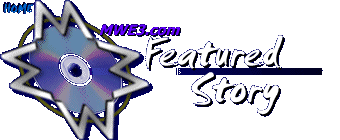JUSTIN HAYWARD
beyond
the lost chord
by Robert Silverstein
As an eleven year old kid in 1965, growing up on Long Island, I can
remember thrilling to the sounds of the early Moody Blues songs “Stop”
and the band’s first huge hit, “Go Now”—a song
still spinning on oldies radio stations across the land. “Stop”
was just one of many great songs written by the early Moody Blues
songwriting team of Mike Pinder and Denny Laine. During those early
British invasion years, Pinder and Laine composed many memorable songs
together but sadly, it just was not to be. Mike Pinder’s brilliantly
expansive orchestral keyboard approach was growing by leaps and bounds
and by late ‘66 Laine had left the Moodies. Soon afterwards Pinder—and
his Moodies mates Ray Thomas and Graeme Edge—wisely enlisted
the talents of Justin Hayward and John Lodge.The difference between
the early band and the second Moodies lineup of Pinder, Thomas, Edge,
Hayward and Lodge was staggering. Following a brilliant run of ground
breaking recordings recorded between 1967 and 1973—now referred
to as the Classic 7 and a tentative comeback called Octave from
1978 —Pinder and producer Tony Clarke “the 6th Moody,”
left the fold. Despite protests and consternation from fans over the
fact that the Moody Blues without Mike Pinder just wasn’t the
same—the post Classic 7 ‘quartet’ lineup did remarkably
well during the ‘80s and deep into the ‘90s. Perhaps Pinder
and Clarke will never regain their stature in the band again, yet
2006 looks to be yet another watershed year in Moody Blues history.
A 2006 DVD on Image Entertainment—the first one released since
the recent retirement of early member Ray Thomas—entitled Lovely
To See You Live and the long awaited ‘expanded edition’
CD reissues of the famous Classic 7 Moodies albums on Universal will
no cast the band’s revered legacy back into the limelight again.
One can only hope that Justin, John and Graeme once again realize
what an valuable asset Mike Pinder is to legendary core sound and
invite him to appear with them in the studio on a track or two again.
Until then, we still have 40+ years of classic Moody Blues music worth
a fortune in priceless musical memories. On February 20, 2006, Justin
Hayward spoke with Robert Silverstein about a wide range of Moody
Blues history.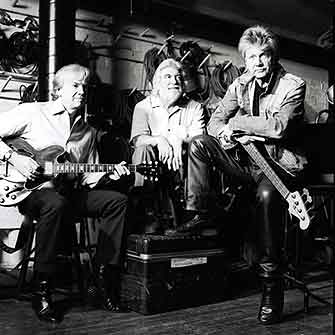
RS: Justin it’s Robert Silverstein from 20th Century Guitar and
mwe3.com Do you have time to do the interview now?
JH: Yes absolutely. We’re here waiting for you. All ready.
RS: How’s the tour going?
JH: Not bad! Glad to be out of the cold. We just did a week in the
frozen north.
RS: Yeah I heard the band was out in Indiana.
JH: That’s right, yeah. It’s going fine. Very good, yeah.
RS: Are The Moody Blues ever not on tour? You’ve been touring
consistently for the past six years.
JH: I know what you mean. Sometimes it seems like I’ve never
done anything else. We’ve been out on the road for six or seven
months each year for the last few years. I think that’s what
people want for us. We’re offered more work now than we ever
were before, strangely enough.
RS: Are there surprises on the set list? How about doing a live version
of “Out And In”?
JH: Oh, wouldn’t that be nice. I love that song. Funny enough,
I did that song at a charity event last year. Just myself. I always
liked the song. I always liked all of Mike’s songs. And I thought,
‘oh, I’ll just do that.’ ‘Cause I’d always
remembered it. And I just stood there meself, with my guitar, and
did it as part of my own set. A few went, ‘what the hell is that?
(laughter) But the ones who knew it were very pleased.
RS: My father just passed away. After hurricane Wilma in the first
week of November he fell ill and just couldn’t get out of the
hospital and he passed away this past January 23.
JH: Oh dear. I’m very sorry...yes. Have you still got your mum
Robert?
RS: Yes we’re trying to bring her back to New York from Ft. Lauderdale,
but I remember when I interviewed you the first time you told me you
went through losing your father at the time when you recorded To
Our Children’s Children’s Children. Any spiritual advice
on coping with big loss of a parent? That whole album seems to hint
at reincarnation, “I Never Thought I’d Live To Be A Hundred”
then “Candle Of Life” “Eternity Road”.
JH: That’s a heavy one, isn’t it? Well nobody who hasn’t
been through it understands what you are going through. I think that’s
the thing. I don’t know...I’ve always tried to keep the
memory of my father alive and to keep his image alive in my mind.
You lose things like the voice and the expressions but as long as
I can just pass it on to my children and hopefully my children’s
children. That’s what I want to do. And to pass on the principals
and what he meant to me and those around him.
RS: The Moodies CD December, released in time for Christmas
2003, is a fine album. What prompted you to want to make a holiday
or Christmas-y kind of record?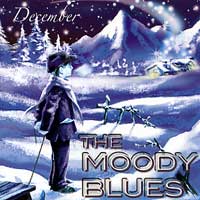
JH: Well it was actually a guy that we were working with, doing some
projects with, called Miles Copeland, who was doing some management
things and he suggested it. At first, I thought it was a terrible
idea and then the more I thought about it, I thought maybe there’s
something in it. And I went down to Italy and worked with the guys
there on a couple things that I always wanted to do. One was a song
called “In The Bleak Midwinter,” which is from the English
hymnal and the other one was a piece of Bach. Bach 147, that I’d
kind of learned when I first started fiddlin’ around in groups
and things like that, but only just as a kind of...almost a jokey,
little party piece. Anyway, I started to sort of think about it seriously.
And once we put those two songs down, the bones of those two songs,
I thought it could maybe work and I was converted to the idea. And
I’m very happy with the album and there’s a song we do on
stage now, “December Snow” that I really, really love and
for that song alone I think the album was worth it. And I hope it
takes it’s place amongst all the other Moodies albums.
RS: It was nice that on December the group covered the Lennon...
and so this is Christmas...
JH: Yes, exactly. That was one of Miles’ chat up lines, was that,
‘hey! John Lennon did it, and Elvis did it and all these other
people, what’s wrong with you doing it?’ So I think it was
a good kind of angle for us. At the same time I think we understand
that the biggest competitor to any record that we’re going to
put out, is our own catalog. Because there’s so much interest
in the back catalog, particularly from Universal, who own it, that
it’s very difficult to try and whip up enthusiasm for new records
when all they want to do is repackage the old stuff. So anyway, that’s
the way it is.
RS: Justin, what guitars are you using on the 2006 Moodies tour? Your
cherry red Gibson from ‘63 must be very valuable.
JH: No, I always use that. I’ve not done a tour, since 1968,
without that guitar.
RS: I know Alvin Lee plays the same guitar, but he won’t bring
it on the road!
JH: Yeah, that’s right. He does. Yeah, I remember. I wonder if
he kept the same one?
RS: Wouldn’t you be afraid to take it on the road?
JH: Well...(sigh) I love it and what’s it for? It’s for
doing gigs. It’s the same for anybody who has those guitars.
Look at Dave Gilmour’s guitars, or Eric Clapton. It’s the
same situation. But everybody wants those kind of guitars. I think
it’s the replacement. It’s not so much its actual value,
it’s just that you couldn’t find it again. You couldn’t
find that. I always look but I just could not find it again.
RS: Being that you’re so synonymous with the cherry red Gibson,
will there be a Justin Hayward signature guitar?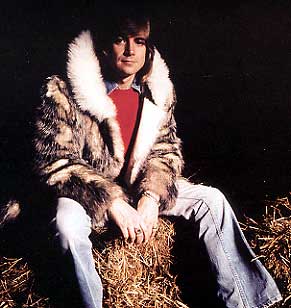
JH: In the ‘80s, I actually designed a guitar with Gibson that
was like a sort of smaller bodied 335 version, but solid. And they
made it for me and of course, when they made it, I realized it was
so heavy (laughter) that it was almost unusable because of the size
of it, even though it was smaller than the 335. But it had the basic
same size but solid. So it wasn’t very practical. And I was a
bit of a failure as a guitar designer from then on. It’s an interesting
thought but, why not? I’d love to do that again.
RS: Your guitar sound is so prominent and your tone is so easily recognizable.
JH: I think a lot of that is to do with the way you play. I mean you
can give somebody the Mark Knopfler guitar and the amplifiers exactly
the same and listen to them play but they won’t sound like Mark
Knopfler. It’s like Hank Marvin, y’know? I’ve played
that Strat that he played “Apache” on. It’s the way
guitar players touch the guitar, the weight of the touch, all of that
kind of stuff that makes the difference. You can give somebody exactly
the same equipment but it won’t sound the same.
RS: I interviewed Jim Messina last month, you know from Loggins &
Messina.
JH: Absolutely.
RS: And he was telling me what great things Fender and Gibson are
doing with their reissues guitars and amps. And I was wondering if
there’s anything new and of interest in the guitar world for
you?
JH: Well, I like all of the Roland VG8 stuff, particularly for recording
in the studio. And a lot of the things that sound like keyboards on
the December album are actually that VG8. That’s very
handy. Whether I would take it on the road, I don’t know. The
Eric Johnson Strat I love very much too. That’s brilliant. We
did a couple of tours with him, must have been in the early ‘80s
I think, and I was blown away by his style. And as soon as he brought
one out, I was on it to see what it sounded like. And I love that
one very much. But the best thing I’ve discovered in years is
Collings. You know Collings guitars? I think they’re from Houston
or Austin. Now, I got one of those in Nashville last year and I’m
almost tempted to say it’s the best acoustic guitar I’ve
got. I mean, I’ve got my old D-28, my Martin D-28 that I’ve
had for years, which is wonderful, I would never part with and every
session musician covets it, when they see it. But the Collings has
got something really, really special and unique. And I’m so pleased
that there’s somebody making guitars of that quality right now.
RS: Which model Collings do you prefer?
JH: The one that I’ve got, I got it in Gruhns guitars in Nashville.
It’s just a straight forward dreadnought model. Blond, almost
white top. No real fancy stuff on it. But it’s exceptional.
RS: Which amps do favor live?
JH: I still use a Marshall 50 watt head with a four speaker cabinet.
Then I use a Mesa Boogie on one side of the stereo and a Fender, I
think it’s a pro-reverb on the other side.
RS: Which strings do you use on the Gibson?
JH: Well, on the Gibson, believe it or not, I still use Selmer strings,
which I’ve used since the ‘60s. And when the factory closed
down in the early ‘70s, I bought hundreds...I bought as many
as I could find. And I’m getting close to the end now. But I
still use those. I’ve kept them all well and I only use maybe
two or three sets a tour.
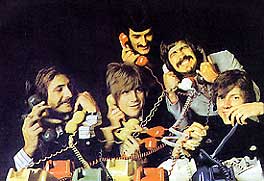
RS: I just got an email from Mike Pinder a couple days ago
and he said, “Good luck on your interview. Tell Justin I wish
him all the best with fond memories of the good times.”
JH: Oh, that’s very kind. And the same back to Mike. I miss
him very much and he was such a valuable part of my life. And I learned
so much from Mike and he was my hero.
Click
here to read more

